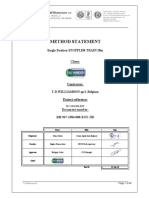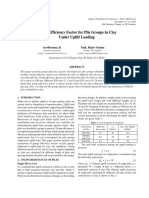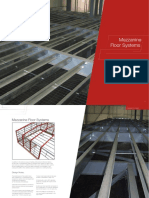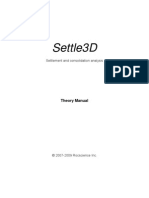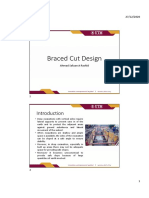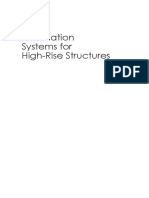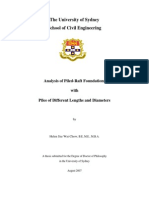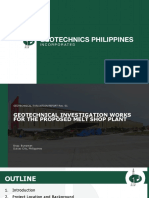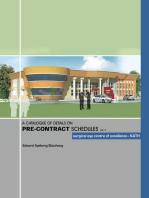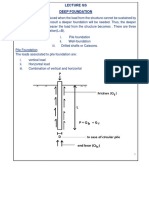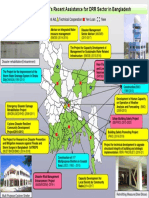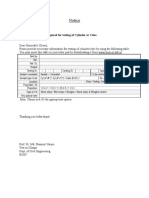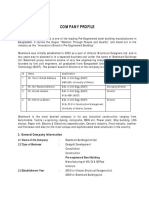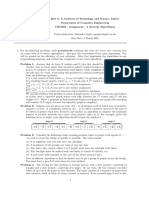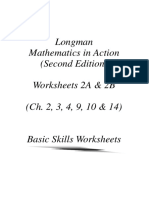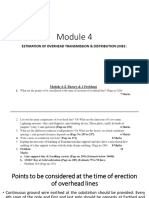Pile Spring
Uploaded by
Azizul KhanPile Spring
Uploaded by
Azizul Khantions are usually obtained as well as, sometimes, bending moments in the top 1 to 3 m of
the embedded pile. From these one might work back using one's favorite equation for lateral
modulus (or whatever) and obtain values to substantiate the design for that site.
Node values (or an equation for node values) of ks are required in the FEM solution for
lateral piles. Equation (9-10), given in Chap. 9 and used in Chap. 13, can also be used here.
For convenience the equation is repeated here:
^ = A , + BsZn (9-10)
If there is concern that the ks profile does not increase without bound use Bs = 0 or use
Bs in one of the following forms:
Bs ( | j = ^ Z " = B'sZn (now input B's for B5)
or use B5(Z)" where n < 1 (but not < 0)
where Z = current depth from ground surface to any node
D = total pile length below ground
The form of Eq. (9-10) for ks just presented is preprogrammed into program FADBEMLP
(B-5) on your diskette together with the means to reduce the ground line node and next lower
node ks (FACl, FAC2 as for your sheet-pile program). You can also input values for the
individual nodes since the soil is often stratified and the only means of estimating ks is from
SPT or CPT data. In this latter case you would adjust the ground line ks before input, then
input FACl = FAC2 = 1.0.
The program then computes node springs based on the area Ac contributing to the node,
as in the following example:
Example 16-9. Compute the first four node springs for the pile shown in Fig. El 6-9. The soil
modulus is ks = 100 + 50Z 05 . From the ks profile and using the average end area formula:
Summary,
,etc.
ks = Profile
Projected pile width, m
Figure E16-9
Example 16-9 illustrates a basic difference between this and the sheet-pile program. The
sheet-pile section is of constant width whereas a pile can (and the pier or beam-on-elastic
foundation often does) have elements of different width.
This program does not allow as many forms of Eq. (9-10) as in FADSPABW; however,
clever adjustment of the BS term and being able to input node values are deemed sufficient
for any cases that are likely to be encountered.
In addition to the program computing soil springs, you can input ks = 0 so all the springs
are computed as Ki = 0 and then input a select few to model structures other than lateral piles.
Offshore drilling platforms and the like are often mounted on long piles embedded in the soil
below the water surface. The drilling platform attaches to the pile top and often at several
other points down the pile and above the water line. These attachments may be modeled as
springs of the AE/L type. Treating these as springs gives a partially embedded pile model—
with possibly a fixed top and with intermediate nonsoil springs and/or node loads—with the
base laterally supported by an elastic foundation (the soil).
Since the pile flexural stiffness EI is several orders of magnitude larger than that of the
soil, the specific value(s) of ks are not nearly so important as their being in the range of 50 to
about 200 percent of correct. You find this comparison by making trial executions using a Ic5,
then doubling it and halving it, and observing that the output moments (and shears) do not
vary much. The most troublesome piece of data you discover is that the ground line displace-
ment is heavily dependent on what is used for ks. What is necessary is to use a pile stiff enough
You might also like
- Earthquake Response Spectrum Analysis of 4 Story Shear BuildingNo ratings yetEarthquake Response Spectrum Analysis of 4 Story Shear Building13 pages
- CEE 9511-Design and Performance of A 46-M-High MSE WallNo ratings yetCEE 9511-Design and Performance of A 46-M-High MSE Wall21 pages
- Environmental & Social Impact Assessment Report of Sirajganj Economic ZoneNo ratings yetEnvironmental & Social Impact Assessment Report of Sirajganj Economic Zone142 pages
- Method Statement: Single Position STOPPLE® TRAIN 28inNo ratings yetMethod Statement: Single Position STOPPLE® TRAIN 28in46 pages
- Soil Stabilization Methods and TechniquesNo ratings yetSoil Stabilization Methods and Techniques43 pages
- PileAXL User Manual - Pile Design SoftwareNo ratings yetPileAXL User Manual - Pile Design Software103 pages
- Experimental Pull-Out Tests and Design IndicationsNo ratings yetExperimental Pull-Out Tests and Design Indications16 pages
- Site Specific Ground Response Analysis PDFNo ratings yetSite Specific Ground Response Analysis PDF9 pages
- 0048 - Uniaxial Bending With Pressure: Description100% (1)0048 - Uniaxial Bending With Pressure: Description7 pages
- Block Shear Failure in Steel Members - A Review of Design Practice PDFNo ratings yetBlock Shear Failure in Steel Members - A Review of Design Practice PDF11 pages
- 2003lam and Teng - Design-Oriented Stress-Strain Model For FRP-confined Concrete100% (1)2003lam and Teng - Design-Oriented Stress-Strain Model For FRP-confined Concrete19 pages
- A Paper On Ground Improvement TechniquesNo ratings yetA Paper On Ground Improvement Techniques18 pages
- Settle3D: Settlement and Consolidation AnalysisNo ratings yetSettle3D: Settlement and Consolidation Analysis56 pages
- Geotechnical Engineering - Ii (Foundation Engineering) : Settlement of PilesNo ratings yetGeotechnical Engineering - Ii (Foundation Engineering) : Settlement of Piles11 pages
- Spreadsheets To BS 8110: Advisory Group Columns at A1, A2 Etc RMWNo ratings yetSpreadsheets To BS 8110: Advisory Group Columns at A1, A2 Etc RMW6 pages
- 14 Comparison of Geotechnic Softwares Geo FEM Plaxis Z-SoilNo ratings yet14 Comparison of Geotechnic Softwares Geo FEM Plaxis Z-Soil6 pages
- Numerical Study For Soil-Spring Stiffness of Pile GroupNo ratings yetNumerical Study For Soil-Spring Stiffness of Pile Group7 pages
- Design-of-Steel-Structures Bhavakkati PDFNo ratings yetDesign-of-Steel-Structures Bhavakkati PDF206 pages
- Norseman Nordic Void Technical & Submittal Information December 2014No ratings yetNorseman Nordic Void Technical & Submittal Information December 201422 pages
- Moormann (2012) German Design of Pile GroupsNo ratings yetMoormann (2012) German Design of Pile Groups20 pages
- (Rev.0 - FINAL) GI Works For Proposed Melt Shop PlantNo ratings yet(Rev.0 - FINAL) GI Works For Proposed Melt Shop Plant90 pages
- Rohit Mourya (Structural Health Monitoring System)100% (1)Rohit Mourya (Structural Health Monitoring System)17 pages
- Numerical Methods and Implementation in Geotechnical Engineering – Part 1From EverandNumerical Methods and Implementation in Geotechnical Engineering – Part 1No ratings yet
- A Catalogue of Details on Pre-Contract Schedules: Surgical Eye Centre of Excellence - KathFrom EverandA Catalogue of Details on Pre-Contract Schedules: Surgical Eye Centre of Excellence - KathNo ratings yet
- Pile Foundation Analysis and Design: Geotechnical Engineering Design IiiNo ratings yetPile Foundation Analysis and Design: Geotechnical Engineering Design Iii24 pages
- Pile Test Finite Element Analyses: Keywords: Pile Test, Loading Frame, Load-Displacement Curve Prediction, Load andNo ratings yetPile Test Finite Element Analyses: Keywords: Pile Test, Loading Frame, Load-Displacement Curve Prediction, Load and8 pages
- Chapter 9: Pile Foundations: Civil Engineering Department: Foundation Engineering (ECIV 4052)No ratings yetChapter 9: Pile Foundations: Civil Engineering Department: Foundation Engineering (ECIV 4052)18 pages
- 7.2 Foundation Modeling For Seismic Loads: 7.2.1 GeneralNo ratings yet7.2 Foundation Modeling For Seismic Loads: 7.2.1 General12 pages
- Design and Analysis of Steel Support Structures Used in Photovoltaic (PV) Solar Panels (SPS) : A Case Study in TurkeyNo ratings yetDesign and Analysis of Steel Support Structures Used in Photovoltaic (PV) Solar Panels (SPS) : A Case Study in Turkey11 pages
- Grant Aid Technical Cooperation Yen Loan NewNo ratings yetGrant Aid Technical Cooperation Yen Loan New1 page
- Periodic Inspection Report For An Electrical Installation: A. Details of The ClientNo ratings yetPeriodic Inspection Report For An Electrical Installation: A. Details of The Client6 pages
- Notice: Subject: Information Required For Testing of Cylinder or CubeNo ratings yetNotice: Subject: Information Required For Testing of Cylinder or Cube1 page
- Pure Earth - Country Director - Bangladesh - 2020No ratings yetPure Earth - Country Director - Bangladesh - 20203 pages
- Urban Area Change Analysis in The Rangpur Sadar Upazila, Bangladesh Using Landsat ImageriesNo ratings yetUrban Area Change Analysis in The Rangpur Sadar Upazila, Bangladesh Using Landsat Imageries7 pages
- Presented By: Nida Ghani, Tamseela Bibi, Mamoona Akbar & Anees FatimaNo ratings yetPresented By: Nida Ghani, Tamseela Bibi, Mamoona Akbar & Anees Fatima47 pages
- Appendix O Contents of The Health and Safety FileNo ratings yetAppendix O Contents of The Health and Safety File5 pages
- PRICE LIST RAPIDROP FROM HM GLOBAL FROM 1-9-2021No ratings yetPRICE LIST RAPIDROP FROM HM GLOBAL FROM 1-9-20211 page
- American International University-Bangladesh: Experiment 10 Lab ManualNo ratings yetAmerican International University-Bangladesh: Experiment 10 Lab Manual4 pages
- 5Guidelines for Business Analytics PaperNo ratings yet5Guidelines for Business Analytics Paper5 pages
- Project Name: Plant Pals Operations: Description Date Status67% (3)Project Name: Plant Pals Operations: Description Date Status2 pages
- Note: SAP's Complete Software Is Written in ABAP in 1989No ratings yetNote: SAP's Complete Software Is Written in ABAP in 19892 pages
- Introduction To ANSYS CFX: Best Practice GuidelinesNo ratings yetIntroduction To ANSYS CFX: Best Practice Guidelines39 pages
- Estimation of Overhead Transmission & Distribution LinesNo ratings yetEstimation of Overhead Transmission & Distribution Lines9 pages









